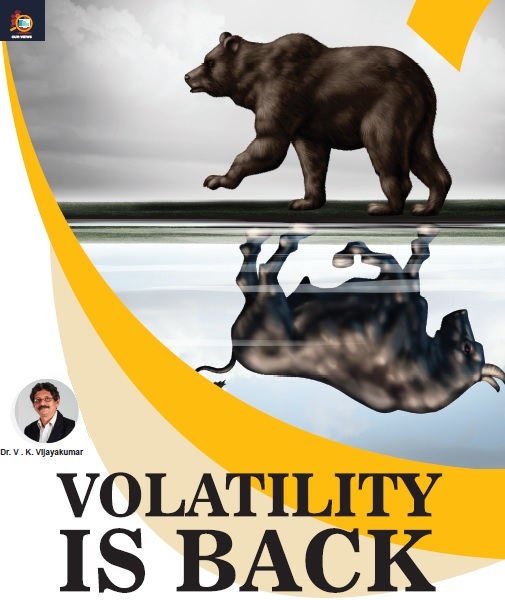By Dr. V. K. Vijayakumar
The sharp correction in stock markets globally in early February came as a timely reminder of market risk. Investors were becoming too complacent following the global bull run of 2017. The 2017 bull run was unique: It was the first year in U S history in which S&P 500 did not decline from high to low by more than 3 percent, at least once. This unique market resilience was the product of pro-risk behaviour, which, in turn, was caused by very low interest rates and steadily improving corporate earnings. This scenario played out in most economies and markets. The synchronized global growth recovery in 2017 was the best in the last 10 years.
The scenario in India has been different. In 2017-18, India’s GDP growth rate would be a 4 year low of around 6.5 percent. The double whammy of demonetization and GST implementation impacted the economy. Corporate earnings have been tepid for 3 years. Still, the market powered ahead. This hope trade was fuelled by a host of factors: expectations of an earnings rebound, poor returns from other asset classes, the liquidity binge unleashed by demonetization, improving financial literacy, financialization of savings and increasing preference for equity as an asset class. The huge liquidity that flowed into the markets in 2017 ensured that all declines were bought into. Amidst the stable global market backdrop, Indian markets also remained resilient in spite of high valuations.
2018 will be different from 2017. Volatility is back.
Why have markets turned volatile
The trigger for the sharp correction in US in early February was the higher than expected rise in wages reported by the US Labour Department. This ignited inflation fears. U S economic data indicates a robust economy with unemployment of 4.1 percent: the lowest in 65 years. Near full employment coupled with fiscal stimulus (Trump Tax cuts and infra spend) is a sure recipe for inflation. If inflation rises sharply, as the market fears, the Fed will turn hawkish and raise rates more than discounted by the market. This inflation scare had a big impact on the market since valuations were high. The Dow fell by more than 1000 points twice in early February. FTSE, DAX and CAC also cracked. Other markets, also suffering from the high- valuation syndrome, followed suit.
There are two possible scenarios that might play out. Those with a bearish view on markets believe that inflation is likely to creep up in 2018 forcing the Fed to turn hawkish; and the 10-year bond yield will breach the 3 percent mark. This will spook the markets that are already trading at high valuations. The bullish view is that inflation will continue to be under control and the synchronized global economic recovery will gather momentum pushing up earnings. There is merit in both views. We will have to wait and see which scenario plays out.
The Indian scenario
The 2018 Union budget was a disappointment, particularly from the market perspective. The reintroduction of LTCG tax, retaining the STT, is unfair. But the grandfathering provision and exemption of capital gains up to Rs 1 lakh are very fair provisions. (The impact of the tax proposals is discussed in detail in page 9). The LTCG tax will not fundamentally alter capital flows into the market.
The budget has not done any harm and is not unduly populist. The fiscal slippage – actual fiscal deficit is 3.5 percent against the target of 3.2 percent – is disappointing, but is not a cause for alarm. With increased revenue buoyancy expected in 2018-19, the fiscal deficit target of 3.3 percent can be achieved. The macro scenario is stable and set to improve.
The political dimension
A crucial factor that is likely to add to market volatility in 2018 is politics. We know from experience that the impact of politics, particularly election outcomes, is huge. The outcome of the next general elections appears less predictable now than what it was 6 months back. Market doesn’t like uncertainty.
The results of the state elections, particularly those in BJP ruled Madhya Pradesh and Rajasthan that go to polls by year-end would be crucial from the market perspective. Any major set back to the ruling dispensation would impact the market.
The FROG factor
Deutsch Bank coined the acronym FROG to summarize the head winds to the economy and markets in 2018. FROG – Fiscal slippage, Rate hike by the Fed, Oil spike and Geo-political issues – would be the potential headwinds in 2018. Populist election eve spending may cause fiscal slippage, which, in turn, would push bond yields further up. The 10 year bond yield which was around 6.4 percent last July, is presently hovering around 7.5 percent levels. Rate hike by the Fed, as already explained, is an issue of serious concern. Oil spiking beyond budget calculations can be another major headwind. Then, of course, there are the unpredictable Geo-political issues, that may crop up anytime. So, watch out for the FROG in 2018.
Investment Strategy
Generally speaking, investment strategy under the present circumstances should be defensive and conservative. Remain invested in quality stocks. Accumulate good stocks on declines. Continue with SIPs. Do bulk investment only through STPs. Avoid bulk investment in small and mid caps. Book profits in small and midcaps where valuations are hard to justify. Move some money into fixed income. Consider investing some money in gold ETFs or sovereign gold bonds.
Since risk appetite varies across investors, different categories of investors can opt for different strategies. Senior citizens can avail of the benefits of exemption of interest income up to Rs 50000 a year by investing in fixed deposits and Senior Citizens Savings Schemes. For young investors with long investment horizon, this would be the right time to start investing in balanced funds through SIPs, since balanced funds perform well during times of high volatility. Disciplined, systematic investment during the volatile days ahead will fetch handsome returns in the medium to long-term.








